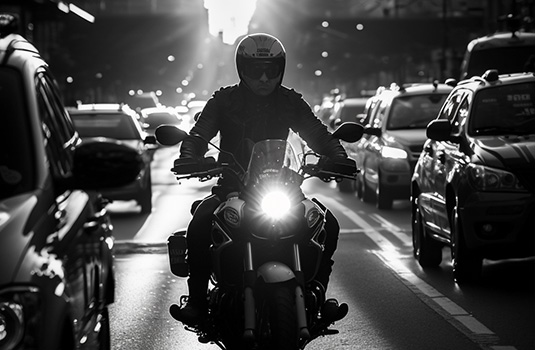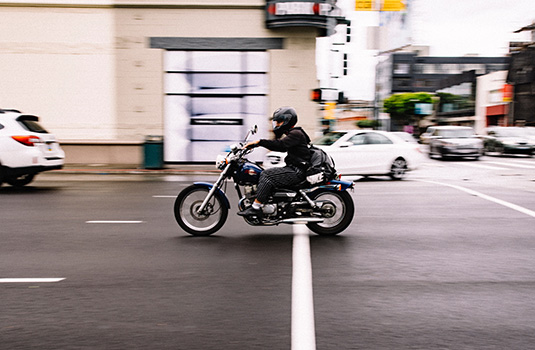- Posted on
- By IASUS_CONCEPTS
- In Information

MASTERING MOTORCYCLE LANE POSITION: A COMPREHENSIVE GUIDE
One of the most crucial components of a motorcycle rider’s safety is maintaining the right lane position. Selecting the proper lane position can assist you in staying visible to other motorists, avoiding road dangers, and communicating your intentions to those around you. A thorough explanation of motorcycle lane position will be given in this article, along with information on the many lane position kinds, things to take into account when selecting a lane position, and how to perform each type of lane position correctly. This book will assist you in honing your abilities and maintaining your safety on the road whether you are a novice or seasoned rider. So let’s start now!
1. What is lane position?
Lane position refers to the location of your motorcycle within your lane on the road. As a motorcycle rider, you have more flexibility in your lane position compared to other vehicles on the road. Proper lane positioning can help you avoid hazards, increase your visibility, and communicate your intentions to other drivers on the road.

1. What is lane position?
Lane position refers to the location of your motorcycle within your lane on the road. As a motorcycle rider, you have more flexibility in your lane position compared to other vehicles on the road. Proper lane positioning can help you avoid hazards, increase your visibility, and communicate your intentions to other drivers on the road.

3. The four types of lane position
There are four main types of lane position that motorcycle riders can use, each with their own unique advantages and disadvantages.
3.1 Center lane position
The center lane position is located directly in the center of your lane on the road. There is nothing inherently unsafe about riding in the middle of a lane. When other vehicles are on either side of you, it can actually be the safest choice because it gives you the most cushion space. However, the middle of a lane is where you’ll find oil slicks, road debris, manhole covers, and other safety hazards.
3.2 Left lane position
The left lane position is located closer to the left side of your lane on the road. This position is ideal for passing other vehicles or when you need to make a left-hand turn. The left position also allows you to see further ahead on the road, giving you more time to react to any hazards. The safest “default” lane position for a motorcycle is in the leftmost third of the lane. Most motorcyclists choose to stay in the left position for the majority of the time they’re on the road. It offers good visibility and a flexible set of escape routes in an emergency. There’s more than one right answer to this question, though.
3.3 Right lane position
Riding on the right side of the lane can be dangerous because it puts you in the blind spot of other vehicles, especially when they are turning right. Additionally, debris and oil buildup are often found on the right side of the road, which can make the surface slippery and hazardous. Riding in the center or left portion of the lane can increase your visibility and reduce your risk of accidents.
3.4 Changing lane position
Changing lane position involves moving your motorcycle from one position to another within your lane. This can be done to avoid hazards on the road or to communicate your intentions to other drivers. Changing lane position should always be done gradually and with caution to avoid accidents.

4. Factors to consider when choosing lane position
There are several factors that motorcycle riders should consider when choosing their lane position, including traffic flow, road conditions, visibility, weather, and road hazards.
4.1 Traffic flow
When choosing your lane position, consider the flow of traffic around you. If you’re riding in heavy traffic, it may be best to stay in the center lane position to avoid any sudden lane changes. If traffic is flowing smoothly, you may have more flexibility to choose your lane position based on your specific needs.
4.2 Road conditions
Road conditions can greatly affect your lane position. If the road is wet or slippery, it’s best to avoid the center lane position, as this can put you at risk of hydroplaning. In this situation, it may be best to stay in the left or right position, where there is more grip on the road. Similarly, if the road is uneven or has potholes, it’s important to choose a lane position that allows you to avoid these hazards.
4.3 Visibility
Maintaining visibility is essential for driving safely. Think about how visible you are to other road users as you choose your lane location. The greatest place to ride in congested areas or at night is in the centre of the lane, where you are more visible to other vehicles. It’s critical to choose a lane location that allows you to see further ahead on the road when riding in a low-visibility region, such as a blind bend.
4.4 Weather
Weather conditions can greatly affect your lane position. In rainy or windy conditions, it’s best to stay in the center lane position, where you’re less likely to be affected by crosswinds or standing water on the road. Similarly, in hot weather, it’s important to choose a lane position that allows you to stay cool and avoid overheating.
4.5 Road hazards
Finally, when selecting your lane location, it’s critical to take into account any potential road hazards. It’s best to choose a lane position that enables you to avoid any hazards like potholes or road debris. Similar to this, it’s crucial to pick a lane location that enables you to avoid any potential door openings if there are parked automobiles on the side of the road.

5. Using Communication Devices to Stay Informed of Traffic
By staying informed of traffic conditions, riders can make informed decisions about lane positioning and avoid potentially dangerous situations. Communication tools such as radios, Bluetooth headsets, and intercoms can help riders stay connected with other riders or passengers and receive updates on traffic conditions, allowing for a safer and more efficient ride. The IASUS Concepts Rekon Motorcycle Comm System allows you to wirelessly connect to your phone; allowing access to your navigation. Waze is a common application to stay informed of the traffic towards your destination and to avoid any road incidents and unforeseen accidents keeps you safer. Having clear audio inside your helmet is also important. A smooth ride is always safer than to have to position yourself to ride through traffic; especially slow moving traffic where cars may be unpredictable.

Conclusion
In conclusion, maintaining the proper lane position is essential for motorcycle riders since it can keep you safe on the road and help prevent accidents. You may considerably lower your risk of being involved in an accident by selecting the proper lane position depending on your individual needs and taking into account several aspects such as traffic flow, road conditions, visibility, weather, and road hazards. It’s critical to keep in mind that each sort of lane position demands skill and caution to execute correctly. When appropriate, you should also use turn signals and hand gestures to let other drivers know your intentions. With these tips and guidelines in mind, you can improve your riding skills, stay safe on the road, and enjoy the freedom and thrill of riding a motorcycle. Always prioritize safety and ride responsibly.






